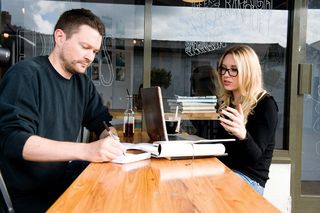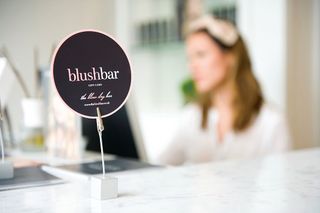Sarah Parmenter on putting herself out there
UX designer and entrepreneur Sarah Parmenter talks to Martin Cooper about success, the web design limelight and speaking up for herself.
Leigh-on-Sea is a coastal town near Southend-on-Sea. After the bustle, concrete and lead-laden air of London, Leigh feels slower, cleaner and somehow cared for. It's like a welcome trip back in time to when Harold Macmillan and Tony Hancock were the stuff of headline news.
Despite its appearances, Leigh is the centre of a thriving web industry and we're here to discuss life online with one of its leading lights: Sarah Parmenter. We find her sat outside a coffee shop, working on a huge MacBook Pro and sipping from an oversized coffee cup.
The idyll is, however, put on pause when we begin by asking Parmenter what the web industry is really like. "Barbie's on stage", she mimics, almost standing up to add greater emphasis. "What, because I've got blonde hair? You're smart. Try again. Try another comment, " she laughs, relaxes, sips and then glances at her computer.
"I get it all the time," she continues. "It happens every time before I step up on stage. It doesn't matter where I am, there will be comments about what I've chosen to wear. I have to pick my outfits ridiculously carefully before I go on stage at web conferences. If you wear a skirt, you're antagonising. If you wear a low cut top, you're antagonising. If you dare do your hair, you're vamping. There's a long list of everything they could get you on."
Speaking up
You'd be forgiven for wondering why she persists in 'putting herself out there', to use her term. (Read Parmenter's now famous blog post, 'Speaking Up'). However, stopping would be giving up. And 'giving up' clearly isn't in Parmenter's vocabulary.
A renowned designer, regular on the web conference circuit and prominent blogger, Parmenter is one of the web's most well-known exponents. She runs her own agency, You Know Who, and has a host of big-name clients to her name, including the likes of BlackBerry, News International, PixelMags and the National Breast Cancer Foundation.
"I'm a user interface designer," she says by way of a summary. "I've been in the web industry for 11, maybe 12 years now. I've been doing user interface stuff for about eight years. Before that, I was coding. I went into design after realising I didn't have a mathematical brain. I love being able to code up my own designs, but it's not my passion."
Be that person
It's this passion for web design that's helped carve her freelance career. "Don't be afraid to put yourself out there, " she states flatly when asked about the secret of successful freelancing. "Don't avoid going up to people at conferences because you feel you're a newbie. By nature, people in this industry are quite wallflower-ish. Quiet people are probably drawn to the fact you can quietly go into yourself and code, which can make it difficult to approach people at conferences."

And, when you start out, don't have more than three months' cash in the bank, she advises. "Any more money than three months and you run the risk of resting on your laurels. That gives you the get up and go to do something about it."
Next, specialise. "It's always better than being a Jack-of-all-traders. If somebody comes up to me at a conference and wants to talk about work, I want to know what they do. I'm always dubious if they're like 'I do a bit of Ruby' , 'I do a bit of jQuery' , or 'I do a bit of PHP'. You really need to be saying that you're ace at Ruby, or you're a fantastic Objective-C developer."
"You've got to be that person, " she says, "That personable person who puts themselves out there and isn't afraid."
Early days
So, how and when did the internet and technology first make an appearance in her life? "I started out coding when I was 12 or 13. When those AOL CDs kept dropping through your door. I was really interested in computers but nobody I knew was doing it as a job. My school was really good but there was no career guidance, so I went into acting."
Fame almost came knocking as she made it to the final stages of selection for two UK TV shows. "I turned into 'Billy Big Bollocks' before I got the parts. You can see how people in the showbiz industry go off the rails. You've got down to the last couple and you think 'well, I'm going to get one of them'. So, I've already [spent the money] in my head. It was down to the TV executives, and I didn't get either. I went into a downward spiral."
Going freelance
Despite continuing to tread the boards, Parmenter's agency was now a year old, so she persevered with her interest in coding. "I thought I could do coding on the side. I had visions of coding in my dressing room. But I never went back to [acting]. It took me so long to get back into loving the web industry, and so long to get [the notion] of acting out of my head, that once I'd settled back into the web, I didn't want to go anywhere."
But it wasn't all plain sailing after she'd turned her back on the footlights. "It was around 2006. I was finding every element of freelancing hard. I was very young and I was trying to make a lot of decisions I had no ground in. I had nothing to fall back on. I guess I was finding my way with no experience and losing my footing quite often."

Disheartened, Parmenter decided to take a more conventional approach to developing her web career and considered taking a nine-to-five job with an agency. "I went for a job interview and they really humiliated me. They sat me in the middle of a room and made me code as they talked, saying, 'we want a list with this, with that'. All the web development team guys stood around me."
The salary was poor and the prospective boss was bragging about his aircraft hanger and his helicopter. "This isn't the place for me," she laughed.
The next day she went to the Future of Web Design conference held in London. "I met loads of people I knew from Twitter. They all said to me everyone goes through this lull when you go freelance."
They told her to push through it, and push through it she did, as well as blogging about her experiences along the way. "I found myself coming out of it. People seemed to like my writing and my honesty."
Approach to design
We discuss how she approaches design. "I do a blend of different things. I prefer looking at an overall inspiration pool like Pinterest. I really like drawing on places I've been too, looking at the architecture." She pauses and laughs, "That sounds really wanky! You can't write that!"
"[My designs ideas] normally always stem from colour. If I get the colour right, I know the rest of it is going to go fine." "I'm not good with fads," she says, citing the current skeuomorphism design trend.
"I prefer looking at user experience problems and solving them rather than throwing fads at it."
So flat design won't catch on? "It's really getting on my nerves at the moment. You know, there's so much [information] that says this new aesthetic of being 'flat' isn't as good in terms of usability. People aren't understanding that those buttons are actually buttons."
Digital first
Despite being flanked by a pile of sketchbooks, she explains her designs seldom start their life on paper. "I normally start digitally first and then the paper side comes when I'm trying to figure out a [specific] design-related problem, like an icon. Is a specific icon clear enough? I don't tend to do full designs of websites on paper any more because of responsive.
"It's the same restriction as a canvas in Photoshop. I haven't found a good way of doing the responsive stuff on paper. You can do multiple sketches, but it's the same as using Photoshop, and I'm a heck of a lot quicker in Photoshop."

We return to responsive. How did its emergence and the move away from pixel-perfect, Photoshop-born websites feel? "I still haven't got it. I don't think we've fully sussed out what responsive is yet. If we think of it in terms of the mobile web, we're edging a lot closer towards what the ideal of it should be.
"I found it really terrifying as I was in an iOS world for a long time. I'd been doing an iOS project for twenty months at the time when Ethan Marcotte's book came out.
"I kept thinking: 'I've really got to sit down and understand what all this is about'. I don't find it easy at all. I find it quite mathematical, which goes back to why I took the design path in the first place."
The point of responsive
Interestingly, she draws a clear distinction between the clever mechanics of responsive - drag a browser window around and see a site reform and restructure - and the purpose of responsive.
"It frustrates me when somebody has gone to the trouble of doing a responsive site but there isn't a way to get at the information they've hidden by doing display:none. There's no way of going backwards. I want the full version because that's where I can get to the thing I want to get to."
And, then, what about helping clients to better understand responsive? "I don't know anybody who could tell you the [perfect] process to move from client meeting to a [responsive site]. I want to see more people blogging about how they answer the questions from clients about information hierarchy. How are they going to decide what's hidden? What are they going to show on mobile? We're too bogged down in the idea that you're going to lose an element that's taken you three days to design and is your favourite part of the giant website. Technology is speedier than our processes."
Responsive workflow
What about the workflow inside her agency? How has responsive changed that? "It's changed my deliverables more. People will still email saying they want finished Photoshop files and I question what they're doing with them. How are you going to make those decisions about how it looks on mobile and tablet? I don't want my designs going out as fixed-width stuff. I don't want my name on that.
"It becomes more of a question of maybe pattern libraries, or do we code up everything as HTML and CSS? Something the developers can use to put designs together."
New venture
As our time in Leighon- Sea draws to a close (and the temperature drops), we discuss her latest venture: Blushbar. "It's the most tech-savvy hair salon in the UK.
"Ultimately, it's been a change of pace from the web thing. I work in big teams where I'm a cog. I was getting fed up. I wanted something I could own. I wanted to know I could come up with the branding, still do the print stuff, still call all the shots on everything that was design-based. And it helped with the client work as I'd want to get it done so I could work on my side project. Basically, I wanted to use everything I learned as a web designer and make a tactile thing. We had a beta period and everything.
"Beyond that," she says finishing her coffee, "I really want to learn Ruby."
Words: Martin Cooper
This article originally appeared in net magazine issue 248.
Liked this? Read these!
- Create a perfect mood board with these pro tips
- The ultimate guide to logo design
- Brilliant Wordpress tutorial selection
Have you found it difficult to 'put yourself out there' in the web design industry? Share your experiences in the comments below.

Thank you for reading 5 articles this month* Join now for unlimited access
Enjoy your first month for just £1 / $1 / €1
*Read 5 free articles per month without a subscription

Join now for unlimited access
Try first month for just £1 / $1 / €1
Get the Creative Bloq Newsletter
Daily design news, reviews, how-tos and more, as picked by the editors.
The Creative Bloq team is made up of a group of design fans, and has changed and evolved since Creative Bloq began back in 2012. The current website team consists of eight full-time members of staff: Editor Georgia Coggan, Deputy Editor Rosie Hilder, Ecommerce Editor Beren Neale, Senior News Editor Daniel Piper, Editor, Digital Art and 3D Ian Dean, Tech Reviews Editor Erlingur Einarsson and Ecommerce Writer Beth Nicholls and Staff Writer Natalie Fear, as well as a roster of freelancers from around the world. The 3D World and ImagineFX magazine teams also pitch in, ensuring that content from 3D World and ImagineFX is represented on Creative Bloq.
